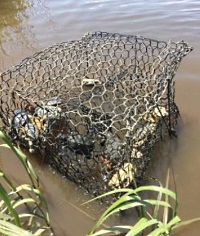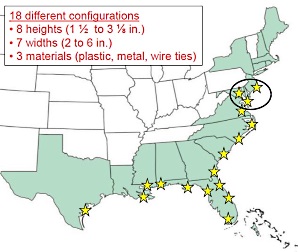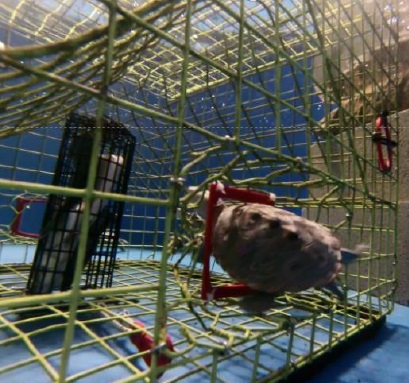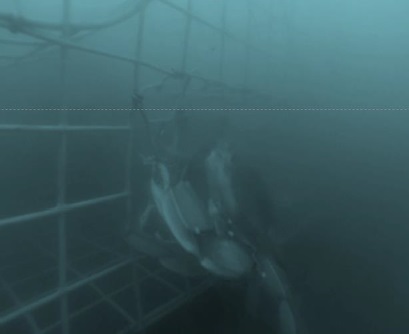Research - Fisheries Interactions and Bycatch Reduction

Drowning in crab traps is considered to be the greatest conservation threat for air-breathing diamondback terrapins7, 22. Although the full magnitude of annual terrapin mortality due to crab traps remains unknown, studies conducted in Virginia23 and Georgia24 report significantly fewer diamondback terrapins (overall and for small individuals) in areas where crab traps are abundant. Although one interpretation of this observation is that crab traps are mostly set in areas where terrapins donft occur, the ability of a single crab trap to capture up to 94 terrapins25 is sufficient cause for alarm to warrant aggressive research into reducing the ability of diamondback terrapins to enter crab traps.

In the early 1990's, a researcher in New Jersey placed a small wire rectangle inside a crab trap entry funnel and observed reduced entry of terrapins larger than the device into the trap26. This device became known as a Bycatch Reduction Device (BRD), and in the past 25 years numerous studies have tested multiple variations on the basic BRD theme in nearly every state where terrapins occur as denoted by the yellow stars on this map. All of these studies demonstrate reduced terrapin entry when traps are fished with BRDs, with the smallest BRDs excluding the most terrapins. However, because mixed results have been reported with respect to blue crab catch, many state legislatures are reluctant to require the use of BRDs in the blue crab fishery, a very important socio-economic engine in virtually every state where diamondback terrapins and blue crabs occur. Furthermore, BRD compliance in at least one of the three states (denoted by circle on map) is low due to a perceived loss of crabs in traps fished with BRDs27. Thus, clearly more work is needed to improve both BRD performance and perception in order to achieve the full conservation potential.

SCDNR researchers first documented entry of diamondback terrapins in crab traps in the late 1970's, but didnft actively begin pursuing efforts to reduce terrapin entry into crab traps until 20062829. Initial terrapin reduction studies were funded through a Cooperative Research Grant to partner with commercial crabbers to evaluate the performance of a large, massproduced plastic BRD. More than 13,000 blue crabs and <100 diamondback terrapins were documented during 2006-2009, which provided useful management insight about times and areas where terrapin captures were most likely to occur. Unfortunately, seasonal reductions in crab catch in traps fished with BRDs discouraged pursuit of requiring these devices in South Carolina.

The SCDNR resumed BRD studies in 2014 during the second year of a State Wildlife Grant, with emphasis on developing a superior alternative (for both terrapin exclusion and crab capture) to the BRD design tested with crabbers during 2006-2009. Crab traps were fished in groups of four by researchers for several hours a day, with each group of four traps consisting of the following configurations: no BRD; BRD design previously tested with SC crabbers; a reduced height version of the previously tested BRD; and a reduced width version of the previously tested BRD that was then rotated 90°. Four hundred trap fishing hours were recorded for each trap configuration and nearly 500 legal-sized blue crabs were captured. Crab size and the ratio of females to males was highly similar in all trap configurations except for the reduced height BRD, but unfortunately all traps with BRDs captured fewer legal-sized crabs. None of the 11 terrapins captured by crab traps in 2014 were associated with the modified BRD configuration.

Collection of several body measurements for blue crabs in 2014 revealed an important BRD design consideration: similar to diamondback terrapins, blue crabs are twice as wide as tall when they enter crab traps. Therefore, it is more efficient to exclude terrapins based on body width than body height, which also allows BRD height to be set to maximize the potential to capture large blue crabs. With this insight, we designed the smallest (2 x 2 in.) BRD ever reported and tested it in 2015. During nearly 500 observation hours per trap configuration (no BRD, BRD in horizontal vs. vertical orientations), more than 500 legal-sized blue crabs were captured. Similar to 2014, size and sex ratio were essentially identical in traps with and without BRDs, but crab catch rates in traps fished with BRDs remain less than desirable. Fifty-seven terrapins were captured, 75% of which were captured in traps fished without BRDs. All terrapins that entered traps fished with BRDs were predicted to be able to enter these traps given their small size; however, based on size distribution for more than 700 terrapins measured in the Ashley River since 2013, this BRD should exclude >90% of terrapins attempting to enter.

BRD research emphasis in 2016 will focus on behavioral data collection to understand why crab catch is reduced in traps fished with our novel BRD design followed by systematic efforts to improve crab retention. Behavioral studies conducted in 2014 and 2015 for graduate research at the College of Charleston30 confirm that large blue crabs are able to enter traps fished with this novel BRD with relative ease, but also reveal difficulty studying crab behavior in a controlled environment. As such, SCDNR behavioral data will be collected using GoPro cameras attached to crab traps fished in shallow water on calm days when ambient light is sufficient for observing crab entry and escapement behavior.
In addition to mitigating crab trap mortality of terrapins, SCDNR is also interested in better characterizing the extent of interactions (and terrapin fate) in other fisheries. Incidental capture of diamondback terrapins in cast nets occurs occasionally, and is rarely associated with terrapin injury given the limited amount of time that cast nets are submerged. Incidental capture of sea turtles by hook and line fishing gears (both after foul-hooking and after taking bait) is reported from fishing piers; thus, there also exists a potential for terrapins to be captured by shore- and/or boat-based anglers. Therefore, reporting such interactions greatly assists with documenting the relative impact of a variety of fishing activities on terrapin populations, which ultimately serves to better inform future management decisions for this species.
